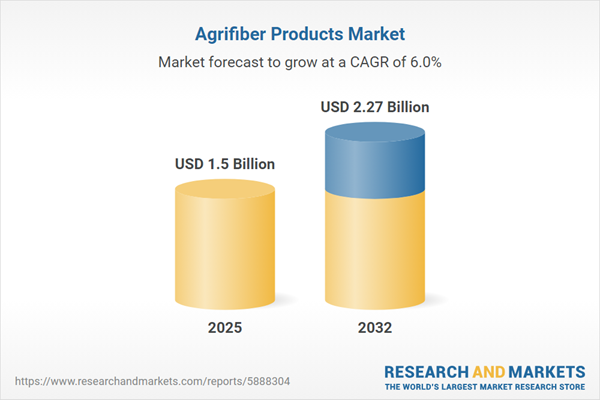Speak directly to the analyst to clarify any post sales queries you may have.
The global agrifiber products market is positioning itself as a critical strategic resource for senior decision-makers committed to advancing sustainable procurement. As organizations face evolving business drivers, agrifiber products align with both environmental and operational goals, helping companies build more resilient, value-focused supply chains.
Market Snapshot: Global Agrifiber Products Market Size and Growth
The global agrifiber products market reached USD 1.42 billion in 2024, is estimated to rise to USD 1.50 billion in 2025, and is projected to reach USD 2.27 billion by 2032, reflecting a compound annual growth rate (CAGR) of 6.03%. This momentum underscores a decisive shift in global industries toward sustainable materials while showcasing the positive impact of circular economy frameworks in procurement strategies. As companies transition from traditional sources to agricultural byproducts, they are improving efficiency and driving market expansion. This trajectory is strongly influenced by investments in advanced manufacturing, regulatory modernization, and collaborative initiatives that are transforming sourcing, operational models, and market entry capabilities.
Scope & Segmentation: Agrifiber Products Market
Understanding the scope and segmentation of the agrifiber products market enables decision-makers to optimize sourcing, improve compliance, and uncover new sources of value across global supply chains. Each core segment plays a distinct role in supporting industry growth and supply-side diversification.
- Product Types: Bamboo, coir, flax, straw, and wood fibers, each tailored for particular sustainability profiles and operational functions, facilitate innovation in fields such as construction, logistics packaging, and textile manufacturing.
- End Uses: Adoption spans agriculture, automotive manufacturing, and packaging, supporting sustainable production and helping organizations increase adaptability to shifting market and compliance expectations.
- Forms: Offered as chips, pellets, powders, and fabrics, these product forms integrate seamlessly with processes like molding, extrusion, or digital manufacturing, providing suppliers options for efficient alignment with client requirements.
- Distribution Channels: Direct sales, retail points, digital marketplaces, and third-party networks drive broad market reach and enable customized sales approaches for diverse procurement environments.
- Covered Regions: The Americas, Europe, Middle East & Africa, and Asia-Pacific stand as primary sourcing and sales regions, each posing unique supply, regulatory, and incentive prospects for market entrants or established enterprises.
- Leading Companies: Industry benchmarks are set by Lenzing Aktiengesellschaft, Grasim Industries Limited, and Sateri Holdings (Hong Kong) Limited, whose practices support responsible sourcing and collaborative industry growth.
Key Takeaways for Senior Decision-Makers
- Integrating bio-based resins and enzyme-assisted methods supports highly tailored technical solutions, driving flexibility in product development for demanding B2B applications.
- Strengthening eco-certification practices enhances supply transparency, giving procurement teams an advantage in navigating increasingly complex standards and global compliance pressures.
- Widening supplier networks and investing in regional processing infrastructure provides risk mitigation, supporting operational continuity in dynamic regulatory environments.
- Collaboration with research groups and adaptive businesses accelerates the adoption of emerging technologies, ensuring timely delivery of efficient and sustainable products.
- Utilizing digital traceability, including blockchain-based platforms, ensures end-to-end procurement compliance and builds stakeholder confidence throughout the value chain.
- Harmonizing digital and traditional procurement models enables organizations to enhance their responsiveness, tailoring solutions to evolving market or client-specific needs.
Tariff Impact: United States Trade Policy and Market Response
Recent changes to U.S. tariffs on imported agrifiber products have increased procurement costs and added complexity to supply management. In response, industry leaders are focusing on diversifying sourcing, expanding domestic capacity, and evolving procurement processes to maintain supply assurance and reduce exposure to market disruptions.
Methodology & Data Sources
Findings are drawn from peer-reviewed literature, regulatory analyses covering sector-specific trends, and widely recognized industry standards. Insights are further supported by interviews with practitioners, third-party audits, and comprehensive on-site reviews, ensuring reliable, procurement-driven intelligence.
Why This Report Matters for Decision-Makers
- Enables senior leaders to benchmark their sustainable procurement strategies and elevate organizational market positioning amid shifting compliance demands.
- Equips procurement teams with actionable segmentation details to make informed sourcing decisions and target supplier partnership improvements.
- Provides targeted guidance on adjustment strategies for evolving regulatory environments and market shifts, promoting resilient and risk-aware decision-making.
Conclusion
Strategic adoption of advanced technologies and targeted collaboration arms senior executives with insight-driven guidance to advance sustainable sourcing. Integrating these approaches strengthens procurement and supports scalable, long-term business growth.
Additional Product Information:
- Purchase of this report includes 1 year online access with quarterly updates.
- This report can be updated on request. Please contact our Customer Experience team using the Ask a Question widget on our website.
Table of Contents
3. Executive Summary
4. Market Overview
7. Cumulative Impact of Artificial Intelligence 2025
Companies Mentioned
The companies profiled in this Agrifiber Products market report include:- Lenzing Aktiengesellschaft
- Grasim Industries Limited
- Sateri Holdings (Hong Kong) Limited
- Kelheim Fibres GmbH
- Rayonier Advanced Materials, Inc.
- Jilin Longking Co., Ltd.
- Aoyang Chemical Fibre Co., Ltd.
- Tangshan Sanyou Group Co., Ltd.
- Shandong Fulida Group Co., Ltd.
- Thai Rayon Public Company Limited
Table Information
| Report Attribute | Details |
|---|---|
| No. of Pages | 199 |
| Published | October 2025 |
| Forecast Period | 2025 - 2032 |
| Estimated Market Value ( USD | $ 1.5 Billion |
| Forecasted Market Value ( USD | $ 2.27 Billion |
| Compound Annual Growth Rate | 6.0% |
| Regions Covered | Global |
| No. of Companies Mentioned | 11 |









